Tianming Liang
TubeRMC: Tube-conditioned Reconstruction with Mutual Constraints for Weakly-supervised Spatio-Temporal Video Grounding
Nov 13, 2025Abstract:Spatio-Temporal Video Grounding (STVG) aims to localize a spatio-temporal tube that corresponds to a given language query in an untrimmed video. This is a challenging task since it involves complex vision-language understanding and spatiotemporal reasoning. Recent works have explored weakly-supervised setting in STVG to eliminate reliance on fine-grained annotations like bounding boxes or temporal stamps. However, they typically follow a simple late-fusion manner, which generates tubes independent of the text description, often resulting in failed target identification and inconsistent target tracking. To address this limitation, we propose a Tube-conditioned Reconstruction with Mutual Constraints (\textbf{TubeRMC}) framework that generates text-conditioned candidate tubes with pre-trained visual grounding models and further refine them via tube-conditioned reconstruction with spatio-temporal constraints. Specifically, we design three reconstruction strategies from temporal, spatial, and spatio-temporal perspectives to comprehensively capture rich tube-text correspondences. Each strategy is equipped with a Tube-conditioned Reconstructor, utilizing spatio-temporal tubes as condition to reconstruct the key clues in the query. We further introduce mutual constraints between spatial and temporal proposals to enhance their quality for reconstruction. TubeRMC outperforms existing methods on two public benchmarks VidSTG and HCSTVG. Further visualization shows that TubeRMC effectively mitigates both target identification errors and inconsistent tracking.
CoopDiff: Anticipating 3D Human-object Interactions via Contact-consistent Decoupled Diffusion
Aug 10, 2025Abstract:3D human-object interaction (HOI) anticipation aims to predict the future motion of humans and their manipulated objects, conditioned on the historical context. Generally, the articulated humans and rigid objects exhibit different motion patterns, due to their distinct intrinsic physical properties. However, this distinction is ignored by most of the existing works, which intend to capture the dynamics of both humans and objects within a single prediction model. In this work, we propose a novel contact-consistent decoupled diffusion framework CoopDiff, which employs two distinct branches to decouple human and object motion modeling, with the human-object contact points as shared anchors to bridge the motion generation across branches. The human dynamics branch is aimed to predict highly structured human motion, while the object dynamics branch focuses on the object motion with rigid translations and rotations. These two branches are bridged by a series of shared contact points with consistency constraint for coherent human-object motion prediction. To further enhance human-object consistency and prediction reliability, we propose a human-driven interaction module to guide object motion modeling. Extensive experiments on the BEHAVE and Human-object Interaction datasets demonstrate that our CoopDiff outperforms state-of-the-art methods.
Long-RVOS: A Comprehensive Benchmark for Long-term Referring Video Object Segmentation
May 19, 2025Abstract:Referring video object segmentation (RVOS) aims to identify, track and segment the objects in a video based on language descriptions, which has received great attention in recent years. However, existing datasets remain focus on short video clips within several seconds, with salient objects visible in most frames. To advance the task towards more practical scenarios, we introduce \textbf{Long-RVOS}, a large-scale benchmark for long-term referring video object segmentation. Long-RVOS contains 2,000+ videos of an average duration exceeding 60 seconds, covering a variety of objects that undergo occlusion, disappearance-reappearance and shot changing. The objects are manually annotated with three different types of descriptions to individually evaluate the understanding of static attributes, motion patterns and spatiotemporal relationships. Moreover, unlike previous benchmarks that rely solely on the per-frame spatial evaluation, we introduce two new metrics to assess the temporal and spatiotemporal consistency. We benchmark 6 state-of-the-art methods on Long-RVOS. The results show that current approaches struggle severely with the long-video challenges. To address this, we further propose ReferMo, a promising baseline method that integrates motion information to expand the temporal receptive field, and employs a local-to-global architecture to capture both short-term dynamics and long-term dependencies. Despite simplicity, ReferMo achieves significant improvements over current methods in long-term scenarios. We hope that Long-RVOS and our baseline can drive future RVOS research towards tackling more realistic and long-form videos.
PVUW 2025 Challenge Report: Advances in Pixel-level Understanding of Complex Videos in the Wild
Apr 15, 2025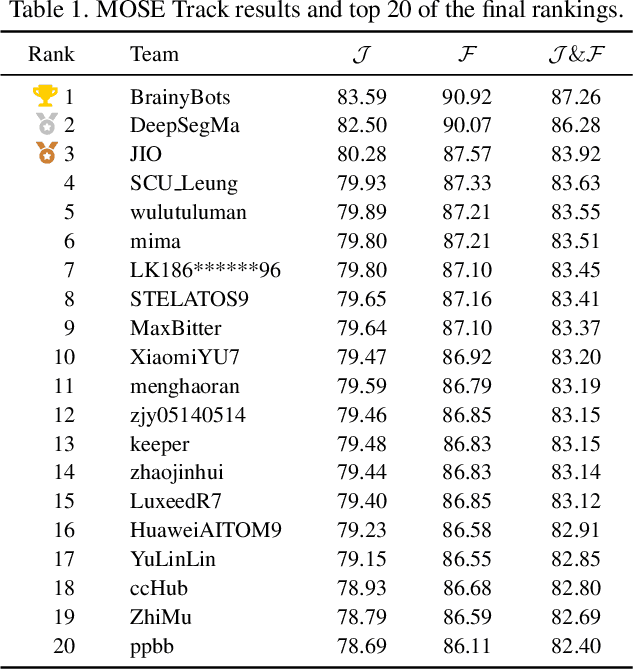
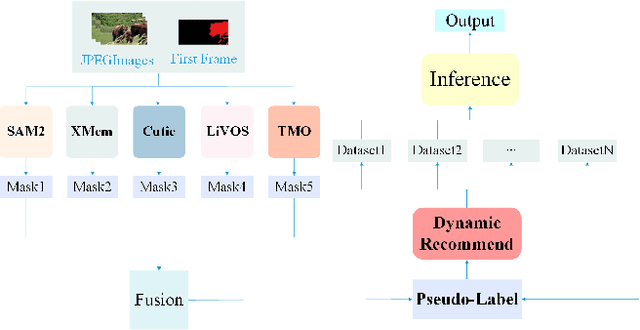
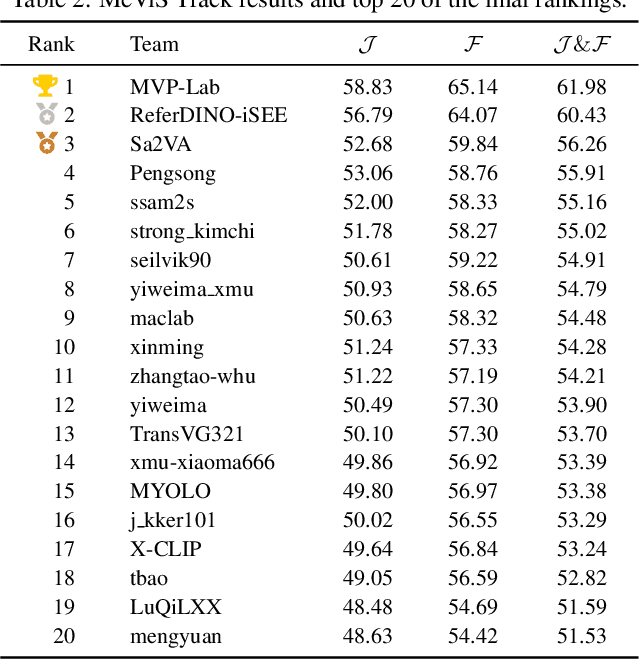
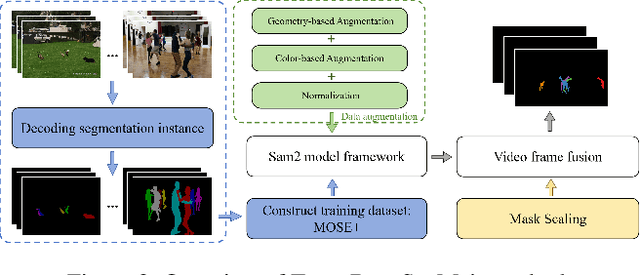
Abstract:This report provides a comprehensive overview of the 4th Pixel-level Video Understanding in the Wild (PVUW) Challenge, held in conjunction with CVPR 2025. It summarizes the challenge outcomes, participating methodologies, and future research directions. The challenge features two tracks: MOSE, which focuses on complex scene video object segmentation, and MeViS, which targets motion-guided, language-based video segmentation. Both tracks introduce new, more challenging datasets designed to better reflect real-world scenarios. Through detailed evaluation and analysis, the challenge offers valuable insights into the current state-of-the-art and emerging trends in complex video segmentation. More information can be found on the workshop website: https://pvuw.github.io/.
ReferDINO-Plus: 2nd Solution for 4th PVUW MeViS Challenge at CVPR 2025
Mar 30, 2025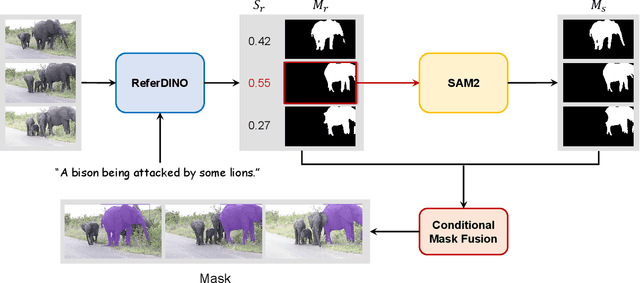
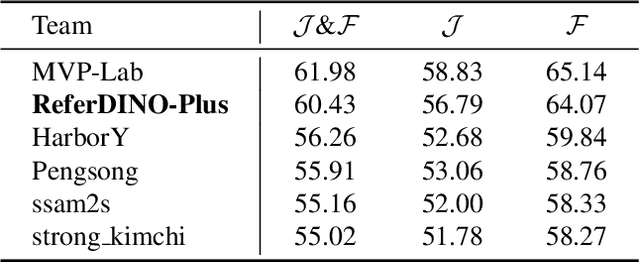
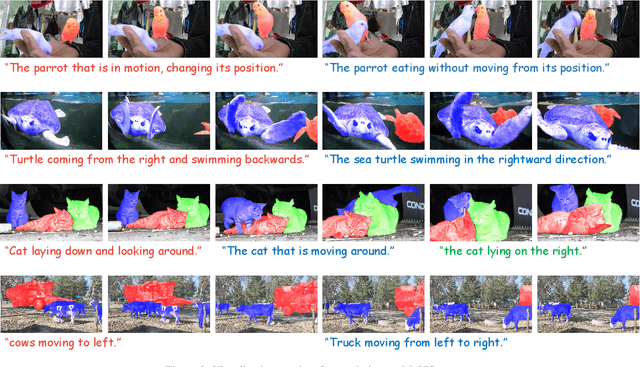

Abstract:Referring Video Object Segmentation (RVOS) aims to segment target objects throughout a video based on a text description. This task has attracted increasing attention in the field of computer vision due to its promising applications in video editing and human-agent interaction. Recently, ReferDINO has demonstrated promising performance in this task by adapting object-level vision-language knowledge from pretrained foundational image models. In this report, we further enhance its capabilities by incorporating the advantages of SAM2 in mask quality and object consistency. In addition, to effectively balance performance between single-object and multi-object scenarios, we introduce a conditional mask fusion strategy that adaptively fuses the masks from ReferDINO and SAM2. Our solution, termed ReferDINO-Plus, achieves 60.43 \(\mathcal{J}\&\mathcal{F}\) on MeViS test set, securing 2nd place in the MeViS PVUW challenge at CVPR 2025. The code is available at: https://github.com/iSEE-Laboratory/ReferDINO-Plus.
ReferDINO: Referring Video Object Segmentation with Visual Grounding Foundations
Jan 24, 2025



Abstract:Referring video object segmentation (RVOS) aims to segment target objects throughout a video based on a text description. Despite notable progress in recent years, current RVOS models remain struggle to handle complicated object descriptions due to their limited video-language understanding. To address this limitation, we present \textbf{ReferDINO}, an end-to-end RVOS model that inherits strong vision-language understanding from the pretrained visual grounding foundation models, and is further endowed with effective temporal understanding and object segmentation capabilities. In ReferDINO, we contribute three technical innovations for effectively adapting the foundation models to RVOS: 1) an object-consistent temporal enhancer that capitalizes on the pretrained object-text representations to enhance temporal understanding and object consistency; 2) a grounding-guided deformable mask decoder that integrates text and grounding conditions to generate accurate object masks; 3) a confidence-aware query pruning strategy that significantly improves the object decoding efficiency without compromising performance. We conduct extensive experiments on five public RVOS benchmarks to demonstrate that our proposed ReferDINO outperforms state-of-the-art methods significantly. Project page: \url{https://isee-laboratory.github.io/ReferDINO}
Progressive Pretext Task Learning for Human Trajectory Prediction
Jul 16, 2024



Abstract:Human trajectory prediction is a practical task of predicting the future positions of pedestrians on the road, which typically covers all temporal ranges from short-term to long-term within a trajectory. However, existing works attempt to address the entire trajectory prediction with a singular, uniform training paradigm, neglecting the distinction between short-term and long-term dynamics in human trajectories. To overcome this limitation, we introduce a novel Progressive Pretext Task learning (PPT) framework, which progressively enhances the model's capacity of capturing short-term dynamics and long-term dependencies for the final entire trajectory prediction. Specifically, we elaborately design three stages of training tasks in the PPT framework. In the first stage, the model learns to comprehend the short-term dynamics through a stepwise next-position prediction task. In the second stage, the model is further enhanced to understand long-term dependencies through a destination prediction task. In the final stage, the model aims to address the entire future trajectory task by taking full advantage of the knowledge from previous stages. To alleviate the knowledge forgetting, we further apply a cross-task knowledge distillation. Additionally, we design a Transformer-based trajectory predictor, which is able to achieve highly efficient two-step reasoning by integrating a destination-driven prediction strategy and a group of learnable prompt embeddings. Extensive experiments on popular benchmarks have demonstrated that our proposed approach achieves state-of-the-art performance with high efficiency. Code is available at https://github.com/iSEE-Laboratory/PPT.
Ranking Distillation for Open-Ended Video Question Answering with Insufficient Labels
Mar 21, 2024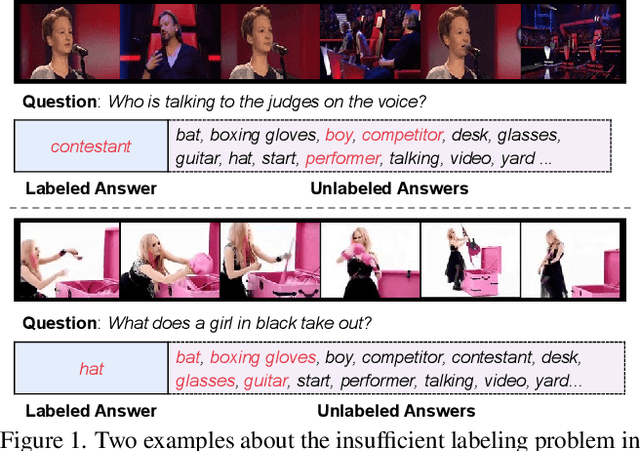

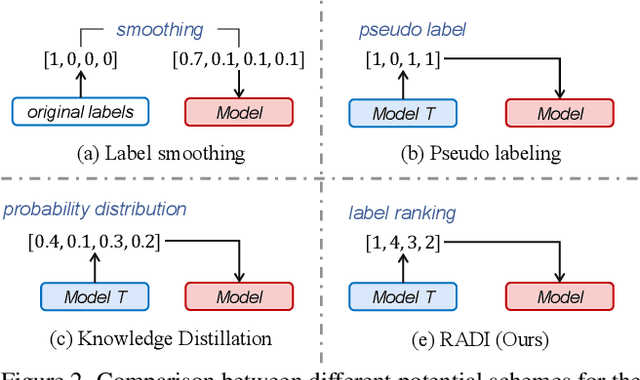
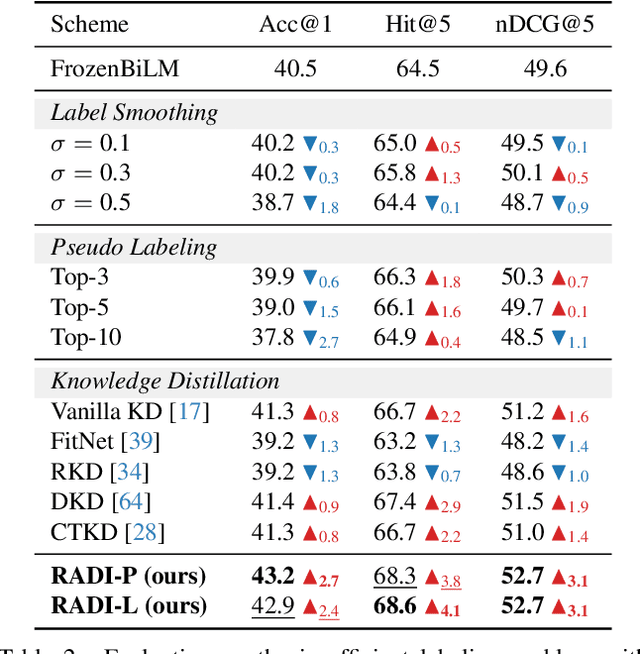
Abstract:This paper focuses on open-ended video question answering, which aims to find the correct answers from a large answer set in response to a video-related question. This is essentially a multi-label classification task, since a question may have multiple answers. However, due to annotation costs, the labels in existing benchmarks are always extremely insufficient, typically one answer per question. As a result, existing works tend to directly treat all the unlabeled answers as negative labels, leading to limited ability for generalization. In this work, we introduce a simple yet effective ranking distillation framework (RADI) to mitigate this problem without additional manual annotation. RADI employs a teacher model trained with incomplete labels to generate rankings for potential answers, which contain rich knowledge about label priority as well as label-associated visual cues, thereby enriching the insufficient labeling information. To avoid overconfidence in the imperfect teacher model, we further present two robust and parameter-free ranking distillation approaches: a pairwise approach which introduces adaptive soft margins to dynamically refine the optimization constraints on various pairwise rankings, and a listwise approach which adopts sampling-based partial listwise learning to resist the bias in teacher ranking. Extensive experiments on five popular benchmarks consistently show that both our pairwise and listwise RADIs outperform state-of-the-art methods. Further analysis demonstrates the effectiveness of our methods on the insufficient labeling problem.
Sentence Bag Graph Formulation for Biomedical Distant Supervision Relation Extraction
Oct 29, 2023Abstract:We introduce a novel graph-based framework for alleviating key challenges in distantly-supervised relation extraction and demonstrate its effectiveness in the challenging and important domain of biomedical data. Specifically, we propose a graph view of sentence bags referring to an entity pair, which enables message-passing based aggregation of information related to the entity pair over the sentence bag. The proposed framework alleviates the common problem of noisy labeling in distantly supervised relation extraction and also effectively incorporates inter-dependencies between sentences within a bag. Extensive experiments on two large-scale biomedical relation datasets and the widely utilized NYT dataset demonstrate that our proposed framework significantly outperforms the state-of-the-art methods for biomedical distant supervision relation extraction while also providing excellent performance for relation extraction in the general text mining domain.
Distantly-Supervised Long-Tailed Relation Extraction Using Constraint Graphs
May 29, 2021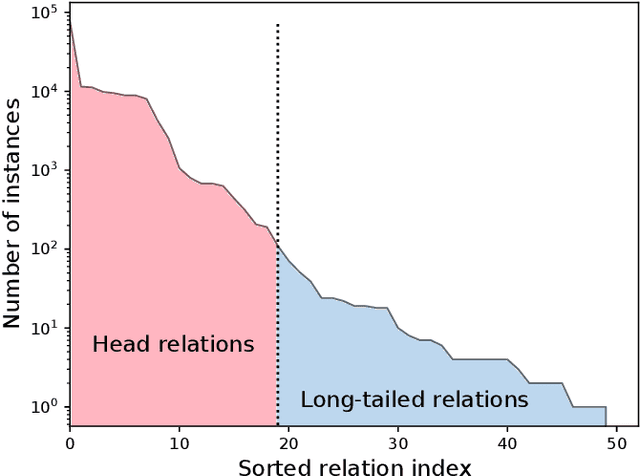

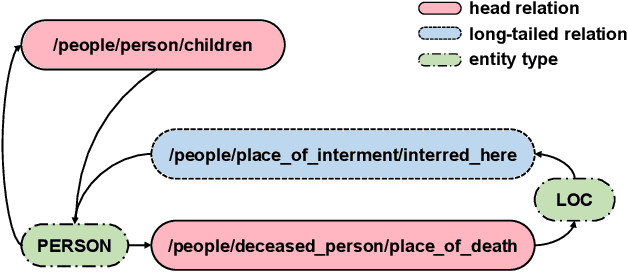
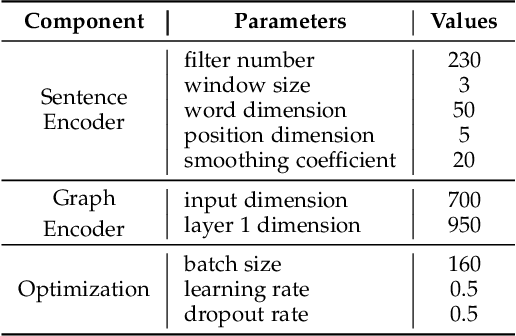
Abstract:Label noise and long-tailed distributions are two major challenges in distantly supervised relation extraction. Recent studies have shown great progress on denoising, but pay little attention to the problem of long-tailed relations. In this paper, we introduce constraint graphs to model the dependencies between relation labels. On top of that, we further propose a novel constraint graph-based relation extraction framework(CGRE) to handle the two challenges simultaneously. CGRE employs graph convolution networks (GCNs) to propagate information from data-rich relation nodes to data-poor relation nodes, and thus boosts the representation learning of long-tailed relations. To further improve the noise immunity, a constraint-aware attention module is designed in CGRE to integrate the constraint information. Experimental results on a widely-used benchmark dataset indicate that our approach achieves significant improvements over the previous methods for both denoising and long-tailed relation extraction.
 Add to Chrome
Add to Chrome Add to Firefox
Add to Firefox Add to Edge
Add to Edge